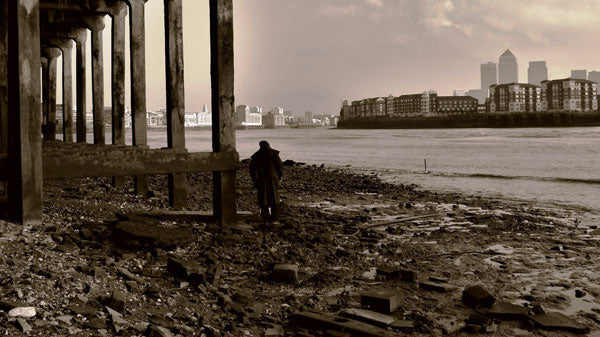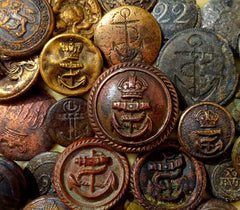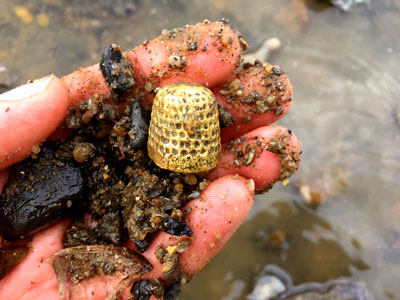Mudlarking We Will Go

By Jason Sandy
When the tide recedes in London . . .
Unusual and mysterious objects appear! Imagine searching for colorful sea glass on your favorite beach and stumbling upon an ancient Roman artefact which is thousands of years old. When my Dad who lives in Chicago came to visit me in London, I took him ‘mudlarking’ (beachcombing) along the River Thames. As we were walking at low tide along the river’s edge, we noticed a small object lying amongst the stones. As I carefully picked up the artefact, we realised that it was a delicately carved piece of bone.  After showing it to the Museum of London, the historian confirmed that it is a Roman bone hair pin which they dated to AD 43 – 100 based on the ornate female face carved at the top of the long pin. How exciting to think that the last person to touch this artefact was a Roman woman who lived in Londinium almost 2,000 years ago! Judging by the skilfully crafted pin which was found close to the previous site of the Roman governor’s palace, I imagine that she was a woman of distinction with elaborately braided hair, held into place with long, elegant hair pins which displayed her wealth and stature. Perhaps a strong gust of wind dislocated the hair pin as the woman was walking along the river’s edge.
After showing it to the Museum of London, the historian confirmed that it is a Roman bone hair pin which they dated to AD 43 – 100 based on the ornate female face carved at the top of the long pin. How exciting to think that the last person to touch this artefact was a Roman woman who lived in Londinium almost 2,000 years ago! Judging by the skilfully crafted pin which was found close to the previous site of the Roman governor’s palace, I imagine that she was a woman of distinction with elaborately braided hair, held into place with long, elegant hair pins which displayed her wealth and stature. Perhaps a strong gust of wind dislocated the hair pin as the woman was walking along the river’s edge.
It is an incredible feeling to discover and hold an artefact knowing that the last person to touch the object lived hundreds or even thousands of years ago. What a thrill experiencing hands-on history!
Only accessible at low tide for a couple of hours a day, this unique part of London is a tranquil, calm and quiet environment, completely detached from urban life above. As the murky waters slowly recede and flow towards the sea at low tide, the exposed riverbed becomes an enchanting and mystical place where time has stopped. The surface is an eclectic mixture of rocks, oyster shells, broken glass, bricks, terracotta tiles, animal bones, sand gravel, and mud. Hidden within this terrain are historical artefacts deposited or dropped into the river centuries ago waiting to be discovered and reveal long-lost stories. As the longest archaeological site in Britain, the foreshore of the River Thames contains an incredible amount of historic artefacts which even pre-date London’s existence.
So, what is "mudlarking"?
 Meriel Jeater, Curator in the Department of Archaeological Collections and Archive at the Museum of London, explained that, “Mudlarking as a profession started in the late 18th and then into the 19th century, and (it) was the name given to people literally scavenging for things on the riverbank and selling them.” These original mudlarks were often children, mostly boys, who would earn a few pennies selling things like coal, nails, rope and bones that they found in the mud at low tide. “Anywhere there was river traffic, you’d find mudlarkers lurking to pilfer, as the Thames was a major trade route,” added Jeater.
Meriel Jeater, Curator in the Department of Archaeological Collections and Archive at the Museum of London, explained that, “Mudlarking as a profession started in the late 18th and then into the 19th century, and (it) was the name given to people literally scavenging for things on the riverbank and selling them.” These original mudlarks were often children, mostly boys, who would earn a few pennies selling things like coal, nails, rope and bones that they found in the mud at low tide. “Anywhere there was river traffic, you’d find mudlarkers lurking to pilfer, as the Thames was a major trade route,” added Jeater.
In the book, London, Labour & the London Poor, published in 1851, author Henry Mayhew interviewed a 13-year old mudlark. “He describes them as pretty much the poorest level of society, scrabbling around on the foreshore trying desperately to make a living,” said Jeater. A mudlark’s income was very meagre, and they were renowned for their tattered clothes and terrible stench. A mudlark was a recognised occupation in Britain until the early 20th century.
Historical Importance of Mudlarking Finds
 Today’s mudlark is different from those poor wretches of the 1800’s. Instead of mudlarking to survive, mudlarks today have a passionate interest in London’s rich archaeology and history. The members of the Society of Thames Mudlarks have found incredible artifacts which have provided new insights into London life centuries ago. They work very closely with the Museum of London and the Portable Antiquities Scheme (PAS) where their finds are recorded.
Today’s mudlark is different from those poor wretches of the 1800’s. Instead of mudlarking to survive, mudlarks today have a passionate interest in London’s rich archaeology and history. The members of the Society of Thames Mudlarks have found incredible artifacts which have provided new insights into London life centuries ago. They work very closely with the Museum of London and the Portable Antiquities Scheme (PAS) where their finds are recorded.
In a television interview, Meriel Jeater stated that, “Over the last 30 years, the mudlarks have made a really important contribution to the study of London history through the sheer volume and variety of finds that they have recovered from the Thames foreshore.” Mudlarks have found numerous toys, like miniature plates and urns, knights on horseback and toy soldiers, which have actually changed the way historians view the medieval period.
“Made mainly from pewter, these medieval toys are exceptionally rare and have helped transform perceptions of childhood during the Middle Ages,” explained Hazel Forsyth, Curator of Post-Medieval Collections at the Museum of London. “These acquisitions are terribly important to the museum. Over 90% of our medieval metals’ collection comes from mudlarkers, and we have developed a special relationship with the Society of Thames Mudlarks over the years, logging finds and in many cases accepting artifacts into the collections.” Over the last 30 years, the Museum of London has acquired over 90,000 objects recovered from the River Thames foreshore.
 Roy Stephenson, Head of the Archaeological Collections and Archive at the Museum of London, noted that mudlarks’ discoveries help fill gaps in the museum’s collection. That’s because, on land, metal objects were often melted down and reused. But if something fell in the river, it essentially vanished. The quality of the artifacts from the Thames is outstanding because of the anaerobic mud (no oxygen). The artifacts come out of the mud in the same condition that they went in. Through these finds, the mudlarks increase the knowledge of the capital’s history. Stephenson added, "We are getting to see some absolutely fascinating things that come off the foreshore."
Roy Stephenson, Head of the Archaeological Collections and Archive at the Museum of London, noted that mudlarks’ discoveries help fill gaps in the museum’s collection. That’s because, on land, metal objects were often melted down and reused. But if something fell in the river, it essentially vanished. The quality of the artifacts from the Thames is outstanding because of the anaerobic mud (no oxygen). The artifacts come out of the mud in the same condition that they went in. Through these finds, the mudlarks increase the knowledge of the capital’s history. Stephenson added, "We are getting to see some absolutely fascinating things that come off the foreshore."
Dr. Michael Lewis, the Deputy Head of Portable Antiquities at the British Museum, said that mudlarks’ finds can “alter our picture of the past. Many of the finds are very small pieces. They are like little pieces in a jigsaw puzzle that help us create a picture of the past,” he observed. “By putting them together we get an idea of what’s going on. They can actually rewrite history.”
 Mudlarking has become a popular hobby in London which gives both adults and children a unique ‘hands on history’ experience and deepens their understanding of London’s past. Many of the significant mudlark discoveries, such as the Roman bone hair pin, are now on permanent display in the Museum of London and other museums in London. That is the absolute thrill of mudlarking – to find, discover, recover, and uncover something new about London’s past which can be shared with future generations.
Mudlarking has become a popular hobby in London which gives both adults and children a unique ‘hands on history’ experience and deepens their understanding of London’s past. Many of the significant mudlark discoveries, such as the Roman bone hair pin, are now on permanent display in the Museum of London and other museums in London. That is the absolute thrill of mudlarking – to find, discover, recover, and uncover something new about London’s past which can be shared with future generations.

Mudlarking on the Thames Foreshore requires a permit. Learn about rules for mudlarking in London ›
Learn more about mudlarking
Learn more about the experiences of mudlarks, who search the shores of rivers, bays, and seas for historical finds and other objects. Articles ›
Learn more about the best beaches and destinations for sea and beach glass, seashells, fossils, rocks, and more beach finds around the world. Articles ›
This article appeared in the Glassing Magazine January/February 2018 issue.








